Adventure games are a mix of different elements including puzzles, arcade sections, RPG Mechanics, and so on. The dominating ingredient of the gameplay mechanics defines the individual type of the game. I have not mentioned the term graphic adventure in the list, since now it is the default standard for most of the adventure games.
In a text-based adventure game, there are no graphics, only text elements (graphics may play the role of minor ornamentation). This is a tribute to the legendary Colossal Cave Adventure and its analogs. It may seem that such types of games are an ancient atavism, but remember that there are some handheld devices that are not quite adapted for quick graphics, such as e-book readers with the screen based on electronic paper. Interactive adventures can be ideally adapted for such platforms, being directly compatible with the general functional paradigm of the e-book devices: displaying text on a screen and support of basic hypertext interactivity. Also, recall audio games; many of them are actually text-based adventures where the content is read out aloud. And don't forget about creative experiments with gameplay, for instance, there is a unique modern game called Blackbar (http://mrgan.com/blackbar/), created by Neven Mrgan, where a player works with text that is censored. The main objective is to figure out what content was painted black.
A puzzle-based adventure is where solo parts are given to various puzzles; as usual, they are pretty complex and look like mysterious devices, mini games, and so on. The best illustration and a true role model for various followers is the famous Myst series introduced in 1993 (the first game of the series and its sequel Riven would later be ported to both iPhone and iPad).
Action-based adventure is a very popular subgenre that not only offers players with a dynamic gameplay with some fights and other types of action, but also requires some intelligent investigation of the story, collecting items, and resolving puzzles. Overall, the game experience is very rich because there are lots of different mechanics involved. Proportions of action and adventure elements may differ from project to projects. There are projects with action and a bit of adventure, where players mainly fight and sometimes get to solve some puzzles. Then there are projects with adventure and some action, where players generally explore the world around them and seldom face any enemies to fight with. A good illustration of an action-based adventure game is Superbrothers: Sword & Sworcery EP from Capybara Games Inc., featuring very stylish pixel drawings:
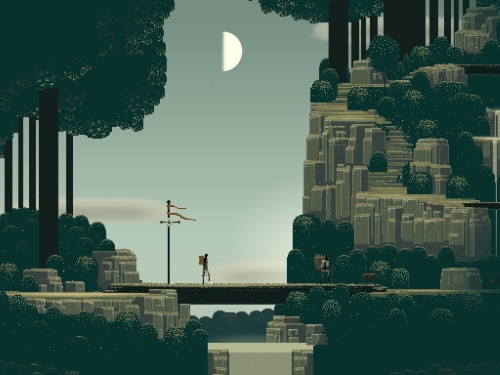
A scene from Superbrothers – Sword & Sworcery EP
Escape the room (room escape) is a pretty young subgenre that was popularized in the 2000s, mostly by various adventure games created in Adobe Flash and were available online for a wider audience. The concept is simple; a player is situated in a locked room and has to find a way to escape it by using various items that can be found nearby. Its popularity among developers is pretty clear. Such a game requires only one small location to work with, so it is much easy to create all the assets and thinkup puzzles. Some of the notable examples were created by the Japanese designer, Toshimitsu Takagi, who stands for popular titles such as Crimson room, Viridian room, Blue chamber, and White chamber. Among projects for iOS, the one that can be specifically picked was called 100 Floors from Tobi Apps Limited (http://www.tobiapps.com/1_100_floors.html), where the connection between levels is illustrated very naturally via the idea of an elevator in a high building. Another interesting entry is Factory96 by Michael Eng (http://www.factory96.com), where real photographs of abandoned industrial locations are used as decorations to create the image of a mysterious factory full of different puzzles.
Adventure games are about mysteries, secrets, and revelations because they need special type of stories to be based on. Events must be incredible and outstanding, denying everyday routine. If the plot is taking part in reality, in most cases, it would be a detective, horror, or survival story. The mystery is always hidden inside somebody's intentions or a dangerous environment. In most cases, the mood of such stories is dark and gloomy.
Alternatively, you may not think about one unique situation but a whole new fictional world based on its original rules. You only have to choose a type of universe you are more attached to: fantasy, cosmic sci-fi, cyberpunk, dystopia, steampunk, dieselpunk, retro-futurism, post-apocalyptic, and so on. All of them can be ideally adapted for interactive adventure games, having a rich stylistic background and a large arsenal of already-invented plot elements. It is worth mentioning that some of the most popular types are fantasy and steampunk settings: the first one lets you introduce magic, spells, and various incredible creatures; however, the second one has passion for various mechanical devices, something that is suitable for the creation of puzzles.
If you're starting with your very first adventure game, it is reasonable to choose the Escape the room concept; it is much easier to develop. All the events take part only in one screen; there are no complex labyrinths, and the sequence of levels can be linear. You only need to think of an idea for the story that would link all the levels together. Where can a bunch of isolated rooms be placed together? In a building? Good! Do you have another idea? A hotel? Sounds good as well, but let's change the point of view a little bit. Rooms should not be necessarily made of bricks or concrete, so think of other materials. Metallic walls? Oh! A train car. Rooms collected together form a train because we want the player to travel from one place to another. Great! What about settings? Steampunk looks like a cliché; it is much better to choose something more original. For example, dieselpunk. Let's give the game a code name: Trans-Terra Express.
There was no WWII in the parallel universe. In the late 1940s, several countries together built a railroad encircling the planet called Trans-Terra Railroad. It covers thousands of kilometers on land, running through major capitals, gnawing through mountains and deep forests, and flying over valleys by elegant arc bridges. Oceans and seas are not barriers anymore as the railroad floats over waves, relying on the grid of special automatic airships.
Trans-Terra Railroad uses special trains known as Trans-Terra Express, which look like small moving cities with huge powerful diesel locomotives ahead. Each express train is made up of dozens of residential cars, including several luxury ones where some famous and rich people may travel with a proper level of comfort. There are also special cars with prestigious restaurants, bars, coffee houses, theaters, cinemas, libraries, and one swimming pool. A few cars carry a collection of exotic plants and have special roofs made of glass; they can be considered as moving orangeries.

This is not a dystopian story, so there are no slums or ghettos in such a train. But there are third-class cars that are much simpler, featuring moderate decoration and smaller living spaces. Also, the last part of the train is an improvised industrial zone consisting of different engineering modules, including boiler rooms, communication centers, waste recycling zone, workshops, storages, and so on.
Trans-Terra Expresses does not have any stops; it is always very hard to accelerate such a mechanical leviathan, and so special small airplanes are used to take passengers on and off the train. They land on the special landing pad, mounted on the forward part of the locomotive. This is not an easy job, so only very professional pilots can manage it. Anna-Amelia, the protagonist of the story, is not a professional pilot. She is not like her father who made more than several thousands of successful landings on Trans-Terra Expresses. But Anna-Amelia dreamed to be a high-quality pilot from her early childhood. She has already had a lot of training and has spent hundreds of hours in the sky, but she has not appeared for the final flying exam yet; she is only a student without official permission to control a plane.
Of course such insignificant aspects could not stop our young hero; Anna-Amelia always tried to create a new exploit by taking her father's airplane without any permission. Once she decided to land on a moving Trans-Terra Express to prove her skills, being sure that her father would not abuse her for such behavior and would only praise her talent as a pilot—very presumptuous and unadvised. But this was her temper; Anna-Amelia was a fidget. Early in the morning she took her father's keys, jumped into the cockpit, started the engine, and flew away into the sky. Soon she noticed the express, which was moving from Budapest. Anna-Amelia began to bank the airplane, preparing for the landing.
The face of the train was in front; she started to descend, seeing the lane and all the signal lights—200 meters, 100 meters, 50 meters, and everything was totally under control. Bounce! The landing wheels touch the lane softly; Anna-Amelia was smiling, anticipating her glory. But, what was wrong with that grid at the end of the lane? It moved too fast! Anna-Amelia accidentally made a common mistake. The landing speed was too fast, and the length of the lane was not enough for it. Before she can completely understand all the consequences, a special automatic system made its way and the young pilot was catapulted. Anna-Amelia only noticed the airplane getting crushed into the grid. She was flying forward, and the roofs of the cars below were moving very fast. Then she saw that the express was going to run away, and the very last car was in front of her eyes. It looked very beautiful with a special decorative fin. "Oh, I see the rails," she thought and suddenly something pulled her back strongly.
The parachute was opened and it caught the fin on the roof. Anna-Amelia was thrown down and backward; she smashed into a door:
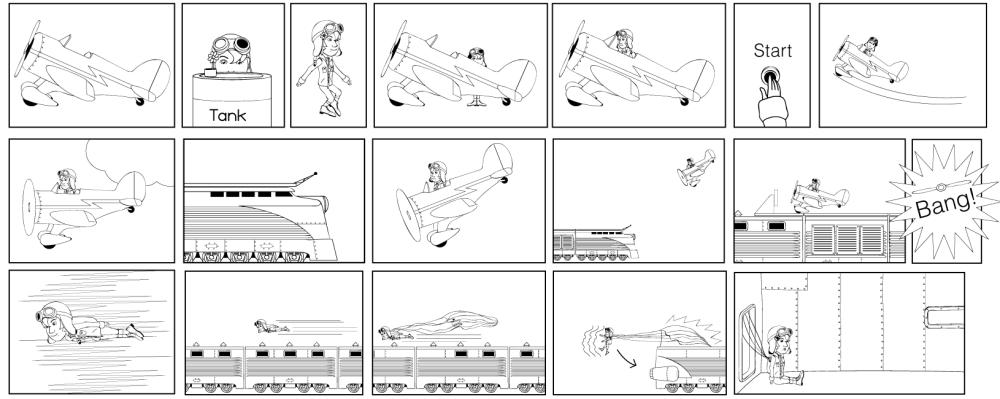
Fortunately it was open and our hero did not suffer any damage. She got off with nothing more than a fright. Or may be not? "My father's plane! I need to get it back, fix it, and turn it home before somebody knows!" Anna-Amelia thought. By looking around she understood that she was inside a very dusty and an almost empty car. Anna-Amelia had to react fast. She needed to travel all through the train, car by car, to reach the locomotive, where the airport facilities were placed. That would not be easy, but Anna-Amelia was ready for adventures.
The main hero of Trans-Terra Express is a young female. She is funny, pranksome, brave, and very curious. She is very cute and sweet as well. Being a young pilot, she wears a special helmet, goggles, and a jacket with a warm collar and riding breeches. Also, there is a flower at the corner of her helmet:

Despite the fact that adventure games can have different types of location, including open spaces, it is easy to call any given isolated zone as a room. In Trans-Terra Express, this term describes a train car. To make the game more complex, each room is made up of a couple of screens; the player may explore either sides of these screens. You may also introduce longer cars consisting of up to four screens that gives the player an opportunity to explore larger spaces.
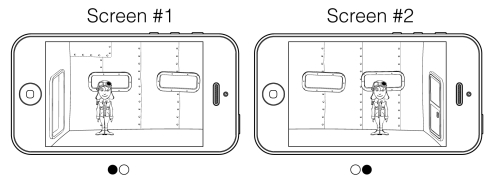
The background is fixed. The protagonist may walk in any horizontal direction; as soon as she reaches the joint between screens, the game displays another part of the room. To express the idea of a running train, windows should be transparent, showing a blurred moving background with parallax effect simulation applied on it. It should not include any particular elements, only general images of faraway hills, trees, and utility poles; in this form, the background will not distract the player. To add some additional realism and dynamics from time to time, the game may show a portion of dark rectangles distorted by a strong motion blur effect, which moves from right to left faster than the background, simulating a train running in the opposite direction. The demonstration of a framework of a railroad bridge is a good idea as well.
Ideally the interior of each car should be made of one unique picture that provides the best artistic effects but requires more illustrative efforts. Alternatively, the interior can be constructed via graphic tiles of different design; using proper combinations, you may achieve diversity in a room's visual appearance.
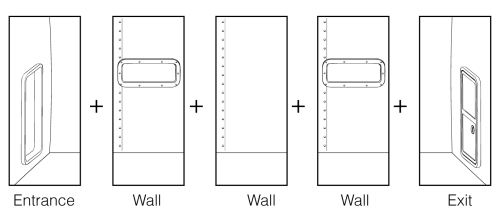
An example of tile-based interior of the room
Each room has two axes that determine the effect of game objects on the protagonist's movement. The axis of the environment is situated near the front wall. Various props, Non-player characters (NPCs), and interactive elements can be placed here. They do not hamper our main hero's walking at any point. On the contrary, if an object or an NPC stays on the axis of the movement, they turn into an obstacle for the protagonist. The player needs to figure out how to remove such elements from the path.

As you already know, the game should not look monotonous. However, the rooms can become boring even if their design is pretty diverse. This is because of a closed space and identical patterns of general components. Sometimes you need to change their appearance more radically. In several sections of the game, Anna-Amelia can leave a car (by special ladders or lifts) and travel some distance on the roof. Here are some unique types of puzzles that can be implemented together with some arcade mini-games. For instance, it is worth to note that Trans-Terra has a special compact railroad on the roof of its train cars; it was developed for various maintenance purposes and for faster transfer through different parts of the train. Small two-seated rail vehicles called draisines are used on this railroad. The protagonist may take part in a simple race of such vehicles. As for background decoration, utility poles with some arcs of wires may look very cunning.
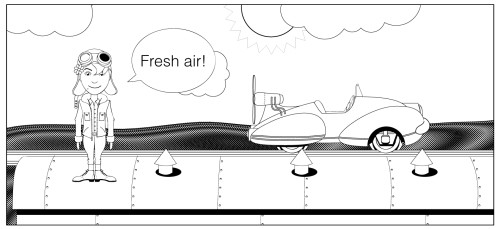
Another way to change the mood of rooms is to switch off the light. Later in the game, Trans-Terra Express enters into a very long tunnel, which actually does not finish until the player leaves some specific rooms. So there is no daylight; only rare signal lights are visible from the windows. If a room has no electricity for some reasons (it is completely dark), Anna-Amelia has to use a flashlight or safety matches to look around. Here the game may even frighten the player.
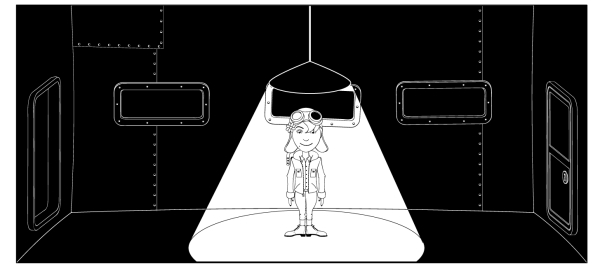
As with many traditional 2D adventure games, Trans-Terra Express uses the point-and-click paradigm (for mobile devices, the term can be altered into the point-and-tap feature). A player tapping the screen moves the protagonist to a specific point. Tapping is contextual, so if an object is touched, it is either collected into the inventory or explored. The player can also push some items as crates or other various types of junk arranged at the axis of the environment. In many cases, the objective is to find a precious item, such as a key, hidden behind useful props.
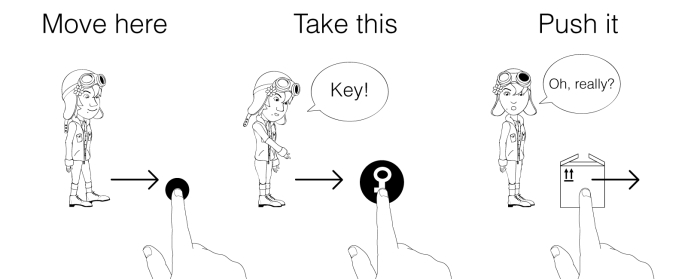
The logic of adventure games can be figuratively considered as a primitive language, or better still, a dialect (very close to the telegraphic style because there are no articles, conjunctions, copulas, and prepositions in an apparent form) that describes situations and actions in the scene. It is made up of several basic parts:
- Nouns: All the objects in the game have their unique names, for example, a Key, a Door, a Lock, and so on.
- Adjectives: These illustrate the current state of an individual item. Their role is pragmatical rather than ornamental. Their main goal is to signal whether an object is in order, broken, locked, and so on. Most popular entries are Locked, Broken, and Busy.
- Verbs: This is a list of actions a protagonist can commit. Its length is directly correlated with the complexity of the game. The basic list consists of simple verbs in imperative form such as Check, Use, Combine, Push, and Talk.
The gameplay of an adventure game is an improvised conversation. The game is telling a story by short descriptions (declarative sentences), but the player may ask some questions or give some commands in the form of an imperative sentence, which I call the action sentence.

Imagine that there is a room with a door and a mat below it. Here is an example of a dialogue that may occur between the game and a player:
Game [description]: "Protagonist," "Room," "Door," and "Mat"
Player [action sentence]: "Protagonist," "Use" and "Door"
Game: "Door" and "Locked!"
Player: "Protagonist," "Check," and "Mat"
Game: ""Mat" and "Movable"
Player: "Protagonist," "Push," and "Mat"
Game: "Space below mat," "Key," and "Donut"
Player: "Protagonist," "Take," and "Key"
Game: "Key" and "Inventory"
Player: "Protagonist," "Use," "Key," and [on] "Door"
Game: "Door" and "Unlocked"
As you see, the game plays the role of a narrator that knows everything about the current situation in contrast to the player who only makes hypotheses. The player needs to explore the game world by touching things and figuratively asking the game, "May I use this one? Does it work for now?" Thus, the objective is to find the right words. If, for example, the player would take Donut instead of Key and tried to use it on Door, the game would answer that the attempt was Ridiculous because the words are pretty incompatible. The action sentence can be compared to the following equation in one unknown where X is the sought-after word:
X "Use"[on a] "Known Object" = "Success"
It is quite easy to find the right word when a sentence is short and the second noun is obvious such as Door. But it becomes trickier if the definition is more vague. For instance, it may look like Unknown Device and the game, in addition, says that it is Broken. How can it be fixed? What spare parts are needed? The equation becomes more complicated with more unknowns:
X "Use"[on a] Y = "Success"
where Y= "Unknown device"
To help a player solve such a logical dilemma, the game should display some hints. These hints may be presented in a graphic form; special images can be used for indirect alludes. Another option is that of a dialogue where an NPC talks about the nature of Y. This is extremely important when compound action sentences are used in the game. Such equations reckon with a specific number of preparatory phases to get the final result. Practically, this means that to solve the puzzle, a player would need to perform few preliminary actions, for example, fix a pipe or add some fuel to a tank. Each preparatory action is an individual equation, and they must be solved correctly to push the final puzzle to work well. Sometimes, without hints, such problems cannot be performed as there are many variables and many combinations.
X "Use"[on a] Y = {
IF A "Use" [on a] B = "Success" and C "Use" [on a] D = "Success" then
"Success"
Else "Not working" }
Note
A linguistic paradigm based on noun-verb constructions was successfully approved by LucasArts in their Script Creation Utility for Maniac Mansion (SCUMM), a scripting language that became the core logic for many graphical adventure games developed by the company, including the famous The Secret of Monkey Island (1990). Its key feature was a compromise between a natural language and a low-level code, as Assembler. Thus, SCUMM could be easily used by game designers without deep skills in programming.
In Game Developers Conference 2011 (http://www.gdconf.com/), Ron Gilbert (one of the creators of the original Maniac Mansion game), in his talk, Classic Game Postmortem - MANIAC MANSION, showed an example of SCUMM's description of a pendulum clock.
In this example we can see the corner-stone of SCUMM: a pair of words, a verb, and a noun divided by a hyphen that defines the object's behavior, for example, play and sound. The idea was to describe each object in the game individually, thus it could be easily added to a scene, removed, or adjusted.
The craft of creating elegant action sentences and hints is real art that requires some experience and flair. The point is in arriving at an equilibrium between the simplicity and complexity of action sentences. If they are too easy to unravel, players are disappointed because the gameplay becomes predictable and routine. On the other hand, if the sentence is hard to understand, the players drop the game and switch their attention to something else, being sure that only artificial intelligence might solve that puzzle because all logical connections are so unnatural. This is the weak point of many adventure games: trying to tangle a player, they forget about apparent logic in their riddles, which become complex and intricate, and require some alien- or machine-like thinking, being free of real-life principles.

By solving a puzzle, a player should deeply understand all the connections between objects and accept them, concurring that in this particular context, they are logical or at least plausible. Understanding them in such a way, the player ascertains that the riddle is pretty natural and can be solved by true work of mind, but not simple good luck that rewards him with a bit of self-esteem and makes him a little bit glad. On the contrary, complex puzzles with unnatural lines of logic, strange twists, and so on looks like an artificial creature without signs of life; being unable to resolve it leaves a nasty taste in the mouth. The common answer to such elements in games is "And how do you suppose I'd guess that?" or simply, "Are you serious?". Therefore, solutions must be hard to achieve, but they should be honest, without a cheating narrative.
As from my experience, a good puzzle fits the empirical 90/10 rule. This means that a player from the start sees 90 percent of the correct answers and tries to figure out the most important 10 percent of the answers that are hidden somewhere. By getting to the right solution, the player exclaims, "Yes, of course! That is logical."
Always try to tangle the player not by strange connections inside an action sentence, but by distracting him with false hints and fruitless items that increase the number of variables. Hide important things partially, as magicians do, by showing something bright and useless in light, but hiding the actual objects in the shadow. Make the player run, search, and calculate; allow him to invent the solution. And always check whether the logic inside a puzzle is universal enough. For example, it can be based on your own knowledge and life experiences, but other people would not understand what you are talking about; therefore, riddles should not be too subjective.
To get some inspiration for puzzle designs, especially when you plan to design riddles based on various devices and mechanisms, try to look at examples of intentionally over-engineered inventions such as the famous Rube Goldberg machines. Having some absurd functions, nevertheless, they include a lot of mechanical revelations and brilliant details, teaching you to plan the connection between elements and to transfer various forms of energy. Moreover, they are, figuratively speaking, very funny. Besides the drawings of the American cartoonist, Rube Goldberg (1883-1970) himself, who actually gave his name to this genre, you also have to look at genial illustrations by William Heath Robinson (1872-1944). He used to invent various more-than-useful devices in his graphics as well.
In an ideal scenario, a puzzle has several solutions, so players may implement different logic and tools to achieve the result, but it is much harder to design as well as to tune the game.
Any episode in an adventure game is an integral organism, a system of interconnected elements rather than individual, independent objects. All parts should work in harmony. To thoroughly draft such cooperation, you need to see the whole picture; blueprinting may help you accomplish that. All the puzzles, interactions, and items should be included in special flowcharts, created on paper. They help to test a scene before you begin to code the different levels of the game. Always begin with the generic line of the scene, planning the general succession of actions that lead to the successful resolution of all the problems; adjust it very carefully. Then switch your attention to all the things that will distract the player—all the fake objectives and false hints.

Local scene flowchart
It is worth mentioning that besides local-plot arcs, there may be longer arcs covering many levels, especially when the game has RPG Mechanics. This means that some discoveries or resolved riddles will prove themselves later; figuratively speaking, a screw nut found at the beginning of the game will be useful at the final level (but the player should take that screw nut through special conditions; otherwise, at the end, the game will be unwinnable). You may intrigue players with such methods by ensuring things and events are full of mystery and, in a sense, hidden. Thus, a global puzzle flowchart should be in hand where connections between levels are shown. It helps to close all the plot lines at the end and ensure that important subjects are not dropped. Innuendos are good dramatic practice, but only designful ones; the arc looks farcically, if it is not properly finished because you simply forget to close them by discarding some story lines.

A global flowchart, showing some long plot arcs
If the game has a lot of variables involved towards the end, and they are spread all over the levels and you are not sure that you can properly control a player's actions (for example, the main character did not pick up a specific item few levels ago and now they are not available), try to secure yourself by deus ex machina solutions. Seeing that some important elements are missing in the final puzzle and cannot be obtained again, the game should activate plan B, an unexpected twist. This is "narrative cheating" and may look crooked, but it is better than letting the player know that the game cannot be finished and needs to be replayed. Moreover, such turns may be gracefully referred to as an alternative ending that especially works fine if you indeed plan for having multiple endings for the story. Players like diversity a lot, so different ways to finish a game are always welcomed; however, it is better to follow only a single rule. Twists in the story in the game should be well expressed, and a new progression of events must be noticeable (but not too much) in some form (via some new phrases in dialogues, another order in items, small changes to puzzle behavior, and so on). For example, the legendary adventure game Blade Runner had about a dozen of different endings. A player's community dreamed to achieve them all by trying to play it over and over again, paying attention to all the paths of the story.
Ironically speaking, adventure games are partially based on greed, for example, a magpie; the player is trying to take or even steal any type of objects, no matter if he knows about its function or not. He becomes a real hoarder, hoping that in future on very special occasion his treasures would become useful.

Screen layouts – on an iPad the inventory panel is always available, but on an iPhone it should be activated by the player
All the items found by the player are stored in his inventory, which works like an improvised backpack. As a rule, its capacity is bottomless; there is no restriction on the number of things you can carry inside it. This is very convenient for debugging as long as you are always sure that a player would not lose an item and would not get stuck somewhere.
Generally the inventory is made up of several basic classes of objects:
- A solo item: This is an item that is required to activate a trigger, to solve a puzzle, to begin a dialogue with an NPC, and so on. It is solid and does not require other elements to operate, for example, a key, a wrench, a flashlight, and so on.
- A spare part: Very often an adventure game asks the player to construct a device or tool based on several other objects. To confuse him, spare parts usually looks like solo items, so a bit of creativity is needed to determine which object should be taken from the inventory.
- A constructed item: This is an object that is made up of several spare parts. Usually it looks like a smart invention, a tool created by a talented autodidact, and not an industrial product. This is the way to creatively wiggle out a situation with stop-gap solutions when there are no actual tools to perform the task. The constructed item is of the same rank as the solo item.
- Junk: This is the most numerous class of items and, figuratively speaking, the funniest one, of course. All such things are only shells without any actual purpose other than to tangle the player's attention, distracting from solo items and the correct spare parts. Use humor to create such objects; for example, it could be an old sandwich, a donut, a left shoe, dirty socks, and so on.
To create a solo item, remember that objects, which should be used for triggers, have a pretty logical and obvious design. These objects include various types of keys and tools, such as a screwdriver or hammer and some missing pieces such as cog wheels, lamps, or wires. There must be an apparent logical connection between the item and the trigger. But items consigned for an NPC may be more exotic and irrational, as long as a character may have some quirks. For example, an NPC can asks the player to bring him something unusual that looks like a caprice; a cup of milk, a firefly, or an old newspaper printed in 1968 and so on.
Constructed items need to be used for unusual tasks or when the actual tools are missing, for example, a screwdriver can be made of a candelabrum and a nail file. Spare parts can be exotic as well, but only at the first sight, as their place in the final design of a constructed item should look very sane and even clever. The construction process is based on the logical addition of separate elements; in the simplest case, there are only two addends in the expression. As might be expected, it obeys the principle of commutativity because it is irrelevant what item of the combination the player would choose first:
"Pipe"+"Newspaper"= "Newspaper"+ "Pipe"
But complex expressions with several items are more tricky. Usually adventure games decline the rule of associativity during the addition procedure; therefore, the correct order of combining spare parts is important. The resulting constructed item should be assembled in the correct sequence. This can be called an in-inventory puzzle where the player has to manipulate with items in his inventory.
Besides the Combine command, its antonym Divide may be introduced as well. Such a verb would help to break up an item into small parts, allowing to create brand new constructed items later. For the sake of simplicity of the UI, it is better to design a special workbench that can be placed somewhere at the game level. By using a solid item on it, the player gets its pieces.
It is worth mentioning that the inventory at the very beginning of the game should not be totally empty; to express the personality of the protagonist, you may include some special and unique items in the list.
You should play with the audience using their little weaknesses (as already mentioned, greed). A hint that an item is very important for a walkthrough of the game, imbue that it is really precious thing the players should be hold dear, keeping like the apple of their eye. And after that, take away the item by forcing the player to use it much earlier than somebody may expect. This will be a very dramatic moment, full of doubts and emotions, because only you as the author know that the thing is not really important, and it is not precious at all; however, the player does not have this information. Here's the illustration. At one of the first levels of the Trans-Terra Express, you may let Anna-Amelia find a propeller. The player already knows that this item is extremely important to fix the airplane. It looks like the key element for the entire game, but we should construct the plot in a different way. The correct propeller would be found much later in the game, so the current one is fake in a global sense since you simply force the player to use the propeller to fix an air-driven draisine.
It is good when characters make some commentaries about game situations or simply share their opinion using short and pithy phrases. This practice has several advantages. First of all, this is the way to express somebody's personality; secondly, the phrases can be considered as the voice of the game. The latter one can speak with a player through the environment, but sometimes the faster way is through words. For example, we are talking about a locked door; when the protagonist touches it, the game reports about the door's state by playing the sound of a clanking lock, displaying a short animation of a shaking door handle (an environmental answer), and forcing the main hero to say, "The door is locked" (verbal answer). Choosing between these two types of answers, you see that the second one is more simple and at the same time very convincing. This does not mean that the environment reaction can be neglected; both types should cooperate to achieve the best results.
One of the creative objectives is to reduce the sameness of phrases. The character's speech about the same situation should be diverse; a special text array can be created, and each sentence can be chosen randomly. The larger the array is the better. Here are a few examples of different phrases in an array:
- Locked door: "It is locked," "I need a key," "Why don't they keep it open?" "I need to figure out how to open it," and "A locked door cannot stop me!"
- Broken device: "It is broken..." "Pile of Metal Scrap!" "It stuck..." "It has seen better days," "Something is missing," "Somebody has seen the manual?" and "I hate machines..."
- Broken button: "Ding dong!" "Apparently it is broken..." "Is something happening?... Don't think so," "May be I have to push again? Just in case!" and "Something wrong with that button"
Always try to add some ironical and funny variants to the array. Remember that your character is not boring but very witty. Excellent phrases may become a one-line joke; players can use these phrases with each other, thereby creating memes.
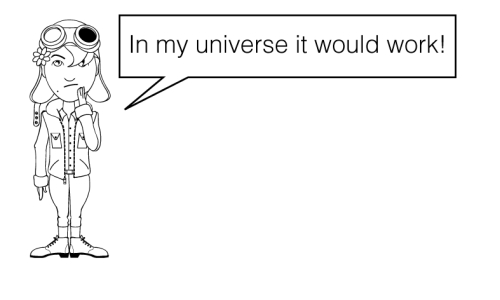
The main domain for monologues is phrases about unimportant elements in game scenes or commentaries about the player's attempts to perform some absurd actions (such as fixing a machine with an apple stub). If the players do something wrong, they should at least smile. Here are a few examples of such phrases in an array:
- Irrelevant object: "Hm-m, very interesting... or may be not," "I'm trying to understand what it is..." "Nonsense", "It is... a thing," "Do I need this?" "Somebody stop me!" and "I'm real idler"
- Absurd action: "I've just want to try," "I'm too genius, nobody understands me," "At least I've tried!" 'I see things differently!" "You better believe it!" "In my universe it would work!" and "You don't see the magic!"
As an option, through the main character's phrases, the game can give some hints if the player is stuck, flouncing between objects, not knowing how to resolve the current puzzle. In this situation, if there is no progress for a continuous period of time, the protagonist may suddenly say, "I have an idea. May be I should try...".
NPCs should also have monologues, uttering some catch phrases or commenting on the protagonist's behavior. They may grumble, say something poetic, capture the attention with loud shouts, and so on.
Now let's see the technical side of the game. Of course, in ideal cases, all the phrases in the game are sound based; recorded voices of humans, reading scripted lines of text is the most natural approach that gives excellent results. But it is not very realistic, especially if this is your first adventure game and you working on it alone or with a small team. Despite the fact that media technology is almost accessible for everyone, it is easy to get a microphone and some software for sound editing; an amateur voice will not sound great because you will not recognize your own voice, thinking that it sounds pretty strange. There are many important nuances both in recording (such as a correct microphone, sound-friendly room, and minimum level of noise) and in voice acting. As far as this goes, it is not about reading a text from a paper but expressing some emotions, acting and using the correct pronunciation of words, and so on; narrating something is a real art. Without proper experience, sound files will be unconvincing.
But hiring real voice actors (remember that you have more than one talking characters) requires some extra budget, which can become even bigger if some additional recording is needed during the beta-testing stage of the product. Since for a first period of time, it is better to be more modest and use only text for phrases in form of subtitles or speech bubbles. In the meantime, to express some vocal tone of the characters, you may record short sessions of mumbling speech. It includes some portion of inaudible talk, such as the sound of a faraway conversation where only unrelated parts of syllables are heard. There should be several types of mumblings—versions for female and male characters—and several types of vocal range to illustrate characters of different age and temper. Because of the lack of a specific sense in them, such sound files are universal and can be attached to any conversation of a corresponding character.
Dialogues play two important roles in adventure-based games. Foremost, they are narrative tools that help to tell a story, expressing details, which are hidden from the player's eye. A dialogue can easily describe events which took place in the past or in another location not shown in the game directly. It may also explain connections between things, giving the player some directions. Thus the graphics, animation, and the level of design meet the audience with a superficial layer of a plot but dialogues reveal deeper layers, making the story more complex and multidimensional. Such an objective can be achieved by using other methods, as the narrator intervenes in the form of text-based diaries speared out on game levels or cutscenes, but the dialogues provide more player's attachment, as long as they imply some portion of interactivity (the players like to be participants rather than silent observers) in the process of familiarization with the plot. This feature is priceless and forms another important role of the dialogue: a text-based puzzle. It can be considered as a first-rate, mini game inside the main story.
A player tries to construct the conversation in a way that he would achieve maximum profit in the form of useful information, items a virtual companion would share, and so on. The challenge can be called a rhetoric battle, where each time the player should choose the right questions to control the direction of the talk. In some form, any interactive dialogue is a classical text-based adventure game.
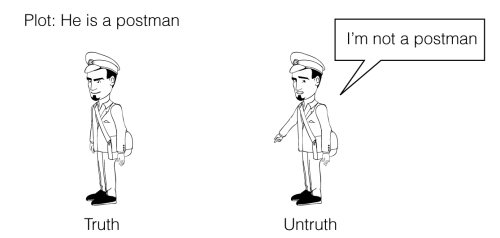
Dialogues have a unique prerogative inside the story. They are allowed to lie; many other narrative tools cannot do the same, otherwise, the story would collapse. Any plot is based on the fact that all the events and things described by plain elements are true. Of course, overall this is fictional (something that was generated by author's imagination), but inside that fictional world, all the descriptions are genuine (may be in a greater degree than some things in our real world). For example, Sherlock Holmes lived at 221B, Baker Street. This was an absolute fact about the great detective inside novels by Sir Arthur Conan Doyle; however, outside them, in real London, it was not. Baker Street did not exist when the novels were published for the first time, so the address 221B simply did not exist. To keep the fictional world solid, Sir Arthur Conan Doyle, as the narrator, must regard all the important facts about it. He could not suddenly write that Sherlock Holmes returned home located at Gloucester place because this information would be incorrect. But he might write that Sherlock Holmes, while trying to confuse some criminals, indicated that he lived at that place instead of his real address at Baker Street. Hence an author cannot distort facts about the elements he has already mentioned in his fiction (this is why innuendos are commonly used if a narrator wants to prepare for a twist; they give some space for unexpected new facts) but his characters can; they may say everything, which is the way you create an intrigue.
In games, this means that elements such as a character's visual appearance, the level of design, mechanics, and so on should have absolute facts. They may evolve and change, but that evolution should be explained and displayed properly. For instance, in a game, there is a bonus that gives a protagonist some extra points. If it suddenly begins to freeze the character, not being change visually, that will be the distortion of the initial fact describing the bonus behavior that is a bad practice. Alternatively, it is better to let a mischievous antagonist tell a false story through a dialogue, say for example, some bonuses are infected. With this, the player begins to doubt, primarily about bonuses, then about the reliability of the antagonist's words. Therefore, the adventures inside dialogues are not only about useful information and the correct order of the conversation, but also about finding the truth. This is why there are a lot of adventure games based on detective stories, where a lot of characters tell lies, and the main objective is to reveal their true colors.
Generally, all the dialogues are predefined structures constructed by a game developer. They cover all the possible variations and turns of the chat. Each phrase may have several directions to be continued, and some sections are looped; there can be different versions of an ending. This structure is called a dialogue or conversation tree, as long as it starts with a straight line of nodes and then grows as the crown of a tree through forking paths of phrases. From the mathematical point of view, this is a directed graph. It is made of nodes (phrases) and edges (directions). The simplest conversation tree consists of only phrases and links to other nodes, wherein some of them are marked as NPC's phrases but others (node's children) belong to the protagonist. It can be considered as some form of a "red–black" tree, a data structure, where nodes have special color marks (either black or red), and children always have the color opposite to that of the parent. Such a method is very visual.
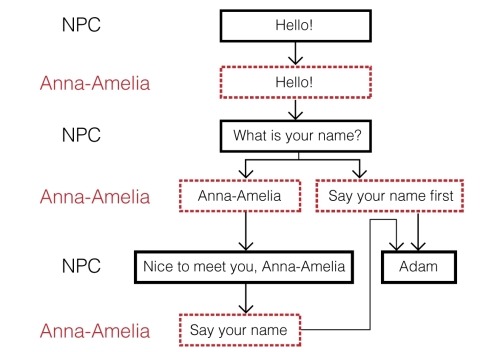
A player surfs the branches of the conversation tree by choosing phrases for the main character, so the focus is shifted from node to node, moving deeply into the crown. The game interprets NPC's nodes as static text but protagonist's nodes as interactive elements. They are kept at the screen until a player would communicate with them (tap), which would move the focus onto the next node.
This type of a conversation tree works fine for isolated dialogs, which are not affected by the current game's situation; also, external variables cannot influence the nodes, so the conversation is mostly decorative. Therefore, more flexible solutions are preferable. The tree should include conditions as follows:

In this case, each phrase had an additional section with few conditional operators, which can check the value of specific variables, changing the direction of the conversation upon them. For example, if a character has no key (key = false), an NPC may offer some help to find it; however, if the character already has this item (key = true), the NPC would tell that a lock is jammed and it knows where to get some grease. As you see such a dialogue is much more natural. It can be even better if a tree node has the opportunity to set up values for variables as well. Therefore, some previous parts of the conversation that are not directly connected with the current node may have an effect on it.
For example, the NPC is caught in a deception because there is a discrepancy between his phrases after that special variable is changed (NPC_liar = true), so in other branches of conversation new variants of player's phrases appear who respond to that variable.
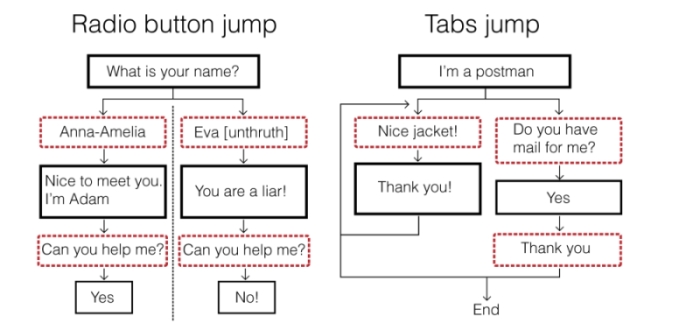
By using variables and conditions, you also construct specific types of transitions inside the dialogue from an analogy to a UI design—I call them Tabs-jump and Radio-buttons-jump . The first one is of the basic type; when the game reaches the protagonist's nodes on the tree, they are put on the screen as interactive elements (buttons). Each of them generates an independent branch of conversation, which can evolve in parallel with others. Such an algorithm is good for phrases that are not connected together; with these algorithms, a player may talk about one thing and then switch to questions about another without the fear of losing some phrases, as if he would use an interface based on tabs. For other cases, sometimes a radio button should be utilized. This means that only one protagonist's phrase can be used at a moment; other branches are cut. Suppose that a suspicious NPC asks a player about his name, there is an option in the conversation tree to tell either the true or false name; both the variants are radio-buttoned nodes since they cancel each other out. When one option is chosen, the other one must disappear. In addition, there can also be hybrids of both types of transitions. As you see, the framework of conversation can be very complex and tangled, making the interaction with virtual character very enthralling.
It is good practice to introduce two possible ways to reach the end of the branch or the conversation at all: the long one for curious players and the short one for fidgets. Those who hurry to continue with adventures and don't like dialogues have the opportunity to choose only key phrases, but other ones may need more detailed descriptions.
Besides the normal conversation, sometimes in the game you may use a so-called lunatic talk, a dialogue based on accident and chaos. It is some sort of slot machine. It is activated by starting a conversation with a special NPC. In most cases the phrases are meaningless and empty, but sometimes something very valuable can be attained. As a rule, such mechanics are utilized for special class of NPCs that can be referred as holy fools, for example, strange and weirdo hobos, old sages, broken robots, and so on. Their speech mostly consists of absurdity and nonsense but sometimes real revelations can be heard; the player only needs some good luck.
Technically, the conversation tree can be designed by a series of conditional statements and string variables storing texts. This is the simplest and obvious way, but it is not perfect but a little bit cumbersome. In this case each dialogue is custom made by code. The system is not flexible, especially for localization purposes, as it is much more difficult to prepare texts for different languages. It is much more effective to use external arrays of phrases and one universal function for parsing that data. In this case, a special standalone dialogue editor can be created (as many game studios do) that saves conversations in special files. The only problem is that of data format because a tree is not a trivial data structure. You can invent your own format based on original tags or reinterpret something that was designed specially for graphs: DOT (graph description language), GraphML, Trivial Graph Format, and many others.
Each node of the conversation tree is a phrase, either answer or question. Your main objective as a game designer is to interest a player to read the text. It is an open secret that some players simply skip dialogues, tapping phrases fast, losing all the narrative and not taking part in textual puzzles. They may even get stuck in the game if they do not note important information. Besides such naughty persons, diligent players can begin to act in the same way if the dialogue is boring, hard to follow, is neither intriguing, nor humorous. Thereby each phrase should be developed very industriously.
First of all, a thing about the width of a text block displayed on the screen. It should not be too narrow or wide. Look at the SMS application for an iPhone; all the blocks of text do not cover the entire width of the screen. If the length of the text is optimal, it's easy for the human eye to focus when it moves on lines. There are no uncomfortable sensations. Choose somewhere about 30 to 35 characters in a line.
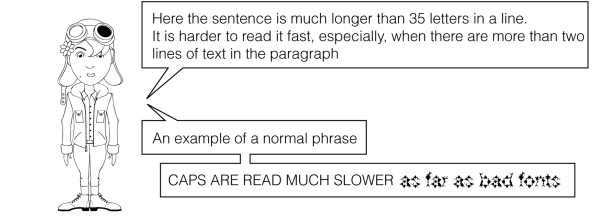
Only typefaces (no matter serif or non-serif) with a look close to classical should be used. Every letter with excess ornamentation or whimsical design is harder to recognize. In an ideal case, the players would not notice the letters at all, moving through them smoothly without trying to grasp the meaning. The entire text in uppercase is bad for dialogues, for example, SINCE PEOPLE RECOGNIZE WORDS BY FAMILIAR PATTERNS, A RELIEF OF LETTERS, BUT ALL-CAPS BROKE THIS RULE; THE READING PROCESS BECOMES TIRESOME AND SLOWER. Therefore more traditional typography methods must be used to keep the optimal level of readability; use uppercase letters only for standard positions.
Any sentence should be short and easy to read and perceive; ideally they should fit in a single line of text. A phrase made of more than three lines may be ignored or read only partially (for instance, only the beginning and final parts). Alfred Hitchcock said, "Drama is life with the dull bits left out". So, try to cut out excessive details by concentrating only on important things. It is better to avoid complex and compound-complex sentence structures, as they are harder to follow and are less natural. Note that when two persons are speaking, they are not using very complex constructions in their conversation because they illustrate many things not by words but by body language, mimics, and gestures. Many of these details can be recreated using animation or graphic representation of different character's emotions.
If in a story a character is long, it must be split into smaller parts; thus it takes few steps for the story to be told. It is worth mentioning that a protagonist can take part in storytelling by asking some leading questions, which include some portions of a narrative. This reduces the number of steps required to express a plot of the conversation. If a sentence is cut and may be continued, it should be marked with an ellipsis. The protagonist's phrase to continue the story can include expressions such as "Please, continue..." "I want to know more," and "I'm all ears".
But there can also be some exceptions. For the sake of drama, to express a character's nature, he can use phrases written in a totally wrong manner. For example, there is a hero, who is very dry as dust and egotistical. He is able to speak for hours admiring himself. His phrases can be very long and pretentiously constructed, featuring splendid metaphors and pompous descriptions. In this case, the exact meaning of the sentences is not quite important. The goal is to tire players with a flood of words so they share the idea that a talking character is a boring person.

There are several ways to draw additional attention to the text or some of its parts. The world of advertising is well familiar with them. Key words in a sentence should be visually isolated from other elements. This can be done by color or other typographical emphasis such as bold or italic font styles, letter spacing (extra spaces between letters), and underlining. Such methods work fine and are pretty effective, however, they require special technical implementation; a text parser used in a game should support special style tags as well as the system displaying the text on the screen.
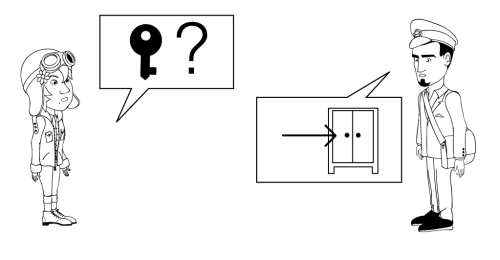
There is a very exotic and at the same time a very creative approach to create dialogues: using graphic icons instead of words. Its main advantage is that it is language independent. It should not be translated into another language when a game is published in foreign markets. The phrases can be interpreted by kids, who cannot read yet, because there are no word sentences. Each dialog box consists of symbolic images, icons that represent a thing or event, special graphic tricks, or simple animations expressing actions (such an approach is used in Machinarium). Of course there are a lot of limitations. It is very hard to illustrate complex plots; moreover, some icons can be unrecognizable by some people and the style by itself is more common for funny and cartoon games. At once, symbolic writing looks very creative and includes a huge potential to create puzzles, since various types of rebuses can be constructed on its base.
In general any dialogue with NPCs is an interruption of the main game process. It is a special mode that looks and feels different to the general gameplay, as a rule it is isolated from all external factors. For example, a character can be killed when he is talking with somebody because any dialogue can be considered as a form of pause of the main game process. Thus, as usual, a special window or panels are activated to display portions of the conversation tree.

One of the dramatic results can be achieved by using the talking head method, which was popularized by the Fallout game series. The NPC that a player is talking with is shown in close-up, so all details of his face and mimics are well seen. Such an approach is very close to cinema, where close-up is traditional practice to illustrate a dialogue scene. The audience is drawn in conversation shown at screen, as if the viewers would stay near the actors. Some games do not change the angle of the virtual camera, so the player only sees the NPC; this is the simplest way but other ones show the player's avatar too. This looks very artistic and meaningful, but you must abide by a simple rule known as the 180-degree rule, which comes directly from cinematography. It defines positions of cameras that are shooting a conversation; it is more like saying that between two characters, there is an imaginary line called the axis of action and the cameras must be placed on the same side of the line and never cross it. This sounds a little bit abstract, but it becomes very obvious as soon as you see the result. When the first character is talking, he is shown at one side of the screen; when the second character begins to speak, he is always displayed on the opposite side. You can check this out for yourself by watching any scene with dialogues in modern movies; recall for example, a famous conversation between Neo and Morpheus in Matrix (1999) when they are sitting in red armchairs. Such a method of displaying the characters on the screen lets viewers naturally understand who is speaking right now without any extra efforts. It works like an easy-to-recognize pattern.
If the rule is broken, the conversation scene is perceived like a series of monologues, as if the characters make some declarations but not communicate with each other:
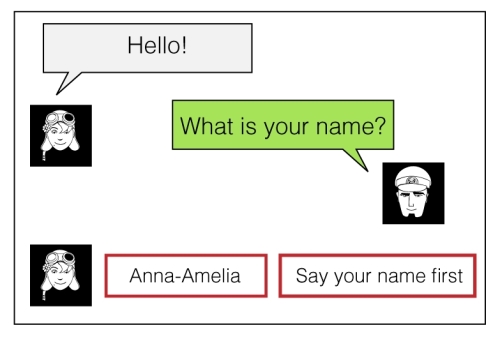
SMS-like-chat dialogue window
The player may have several versions of the next phrase. They can be displayed like individual panels with the text he taps on or look like a scrollable list of text. The last option needs less space on the screen, but it also less visual as some phrases are hidden. It is an interesting practice to keep the inventory panel so the player can use some items from there in his conversation. For instance, by dragging a key from the inventory to the dialogue window, the protagonist asks the NPC about a locked door.
It is important to note that besides a bunch of predefined phrases the player chooses from, the game may utilize something like an emotional spectrum; instead of choosing the exact words, the player selects an emotional state for his character. For instance, he may be cool headed and delicate, or be aggressive and very rude. The game selects directions on the conversation tree following these states.
Not every dialogue window in adventure games has the log feature, which allows to look through the history of the current conversation; sometimes it can be very useful. There is a way to combine the log and the window. I'm talking about a conversation between characters that looks like an SMS chat. Each phrase is presented as a speech balloon, and it does not disappear from the screen; the NPC's ballons are aligned to the left. Special graphics can be used to mark the balloons and to display the current emotions of the character. Any phrase that has been spoken can be accessible at any time; the player only needs to scroll the list. As a creative option, you can expand that feature by gameplay; for example, any earlier words may be used again in the new context, so brand new branches of conversation would be opened by the player.
